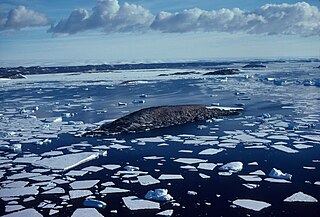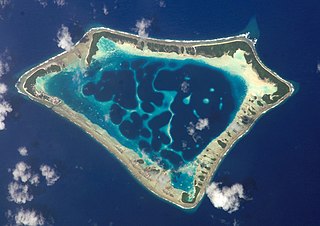
The Prince Charles Mountains are a major group of mountains in Mac. Robertson Land in Antarctica, including the Athos Range, the Porthos Range, and the Aramis Range. The highest peak is Mount Menzies. Other prominent peaks are Mount Izabelle and Mount Stinear. These mountains together with other scattered peaks form an arc about 260 miles long, extending from the vicinity of Mount Starlight in the north to Goodspeed Nunataks in the south.

Denman Glacier is a glacier 7 to 10 nautical miles wide, descending north some 70 nautical miles, which debouches into the Shackleton Ice Shelf east of David Island, Queen Mary Land. It was discovered in November 1912 by the Western Base party of the Australasian Antarctic Expedition under Sir Douglas Mawson. Mawson named the glacier for Lord Denman, Governor-General of Australia in 1911, a patron of the expedition.

Seaton Glacier is a glacier 17 miles (27 km) long, flowing southeast into Edward VIII Ice Shelf at the northwest part of Edward VIII Bay. It was mapped by Norwegian cartographers from aerial photos taken by the Lars Christensen Expedition, 1936–37, remapped, 1954–58, by ANARE and named by ANCA in 1958 for Flight Lt. John Seaton, RAAF, pilot with ANARE at Mawson in 1956.

The Scott Mountains are a large number of isolated peaks lying south of Amundsen Bay in Enderby Land of East Antarctica, Antarctica. Discovered on 13 January 1930 by the British Australian New Zealand Antarctic Research Expedition (BANZARE) under Sir Douglas Mawson. He named the feature Scott Range after Captain Robert Falcon Scott, Royal Navy. The term mountains is considered more appropriate because of the isolation of its individual features.

HMAS Labuan (L3501) was a Mark III Tank Landing Ship that served in the Royal Navy during World War II, and with the Royal Australian Navy (RAN) from 1946 until 1951.
Walkabout Rocks is a prominent rock exposure along the coast at the north-eastern extremity of the Vestfold Hills, about 0.5 nautical miles south of the Wyatt Earp Islands of Princess Elizabeth Land, Antarctica. It was mapped from aerial photographs taken by the Lars Christensen Expedition, 1936-37.
Mount Bartlett is a mountain 3 nautical miles (6 km) southeast of Mount Storer, in the Tula Mountains in Enderby Land. It was plotted from air photos taken from ANARE aircraft in 1956 and 1957. It was named by the Antarctic Names Committee of Australia (ANCA) for A.J. Bartlett, a member of the crew of the Discovery during the British Australian New Zealand Antarctic Research Expedition (BANZARE) of 1929-31.
Budd Peak is a peak, 2,315 metres (7,600 ft) high, 1.7 nautical miles (3.1 km) southeast of Mawson Peak on Heard Island. The peak was mapped by Australian National Antarctic Research Expeditions (ANARE) in 1948, and named by the Antarctic Names Committee of Australia for G.M. Budd, ANARE officer-in-charge on Heard Island in 1954, and leader of the 1963 ANARE Heard Island expedition.
Orton Reef is a reef with a least depth of 2 ft in the north part of Newcomb Bay, located 0.5 nautical miles (0.9 km) north of Molholm Island in the Windmill Islands. Discovered and charted in February 1957 by a party from the USS Wilkes Station, who assisted in an ANARE survey of Newcomb Bay in the 1961-62 season.
Mount Storer is a jagged peak in the Tula Mountains, 4 nautical miles (7 km) east-northeast of Mount Harvey. It was sighted from Observation Island in October 1956 by an ANARE party led by P.W. Crohn. It was named by the Antarctic Names Committee of Australia (ANCA) for William Storer, a radio operator at Mawson Station in 1954.

Turner Island is an island lying 0.5 nautical miles (0.9 km) northwest of Bluff Island and 2.5 nautical miles (4.6 km) west of Breidnes Peninsula, Vestfold Hills, in Prydz Bay. Mapped by Norwegian cartographers from air photos taken by the Lars Christensen Expedition, 1936-37. Remapped by ANARE (1957–58) and named for P.B. Turner, radio officer at Davis Station in 1958.
Patterson Rock is an insular rock 0.5 nautical miles (0.9 km) west of Cameron Island, in the Swain Islands. This region was photographed from the air by U.S. Navy Operation Highjump (1946–47), ANARE (1956) and the Soviet expedition (1956). The rock was included in a 1957 ground survey by C.R. Eklund, who named it for Acy H. Patterson, U.S. Navy, electrician at Wilkes Station, 1957.
Gibbs Glacier is a glacier, 15 nautical miles (28 km) long, flowing southeast into the northern part of Mercator Ice Piedmont on the east side of the Antarctic Peninsula. This feature together with Neny Glacier, which flows northwest, occupy a transverse depression between Mercator Ice Piedmont and Neny Fjord on the west side of the Antarctic Peninsula. Gibbs Glacier was photographed from the air and first mapped by the United States Antarctic Service, 1939–41, and the Ronne Antarctic Research Expedition, 1947–48. It was named by the UK Antarctic Place-Names Committee for Peter M. Gibbs of the Falkland Islands Dependencies Survey, a surveyor at Horseshoe Island, 1957, and leader at Stonington Island, 1958, who was responsible for the first ground survey of the glacier.

Liotard Glacier is a channel glacier in Antarctica. It is about 3 nautical miles (6 km) wide and 6 nautical miles (11 km) long, and flows north-northeast from the continental ice, terminating in a small ice tongue about 4 nautical miles (7 km) west of Hélène Island. The glacier was delineated from air photos taken by U.S. Navy Operation Highjump, 1946–47, and was named by the Advisory Committee on Antarctic Names for Andre-Frank Liotard, the leader of the French Antarctic Expedition, 1949–51, whose group completed the initial survey of the coastal features as far westward as this glacier.
Mount Mather is a peak 3.5 nautical miles (6 km) west of Mount Menzies in the Prince Charles Mountains of Antarctica. It was sighted by Flying Officer J. Seaton from Australian National Antarctic Research Expeditions (ANARE) aircraft in 1956, and was mapped by an ANARE seismic party of 1957–58 led by Keith B. Mather, for whom it is named.
Mawson Corridor is a sea passage between grounded icebergs on the approach to Mawson Station at Holme Bay, Antarctica. It is about 22 nautical miles (41 km) long and 4 to 5 nautical miles wide, opening out at the southern end to give the feature a funnel shape. The northern end at 66°45′S 63°20′E is sharply defined and coincides with the edge of the continental shelf; from there it bears 202°. The passage was discovered by the Australian National Antarctic Research Expeditions (ANARE) in 1954, and was used regularly by ANARE relief ships in their approach to Mawson Station.
McCarthy Nunatak is a small nunatak, the top of which is almost at the same level as the surrounding ice plateau, about 5 nautical miles (9 km) southeast of Depot Peak, Mac. Robertson Land, Antarctica. It was discovered from Australian National Antarctic Research Expeditions (ANARE) aircraft in 1970, and was named by the Antarctic Names Committee of Australia after I. McCarthy, a senior weather observer at Mawson Station in 1970, and a member of the ANARE Prince Charles Mountains survey party in 1971.
The Terra Nova Islands are a pair of small phantom islands. They were thought to lie off Oates Coast, East Antarctica, about 14 nautical miles (26 km) north of Williamson Head in the Somov Sea.

Mount Kelly is a prominent peak,, located 3 nautical miles (6 km) northwest of Mount Burch in the western portion of the Anare Mountains, a major mountain range situated in Victoria Land, Antarctica. The topographical feature was so named by ANARE for Second Lieutenant R.M. Kelly, officer in charge of the army amphibious motor vehicle detachment with ANARE 1962, led by Phillip Law, which explored the area. The mountain lies situated on the Pennell Coast, a portion of Antarctica lying between Cape Williams and Cape Adare.








